Volume 7 | Number 1 | May 2015
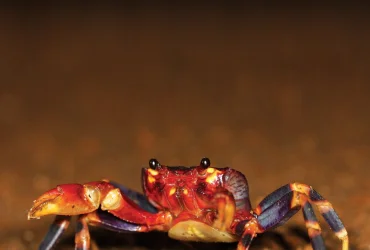 v7i1.161
v7i1.161ISSN: 1800-427X (print)
eISSN: 1800-427X (online)
DOI:10.47605/tapro.v7i1.161
Submitted date: 13 March 2014
Accepted date: 19 July 2014
Published date: 19 January 2015
Pp. 56, Pl. 22.
A nocturnal call of the black ibis (Pseudibis papillosa)
D.S. Shekhawat* & C. Bhatnagar
*Corresponding author. E-mail: sdeependrasingh@yahoo.com
During the night of 12 May 2013, in Udaipur city (24°31'30"N, 73°40'38"E), we heard a harsh sound that could not be associated with any animal. The following morning we observed a pair of black ibis (Pseudibis papillosa) with one juvenile on top of an Azadirachta indica (Meliaceae) tree which was the tallest among all nearby trees. We heard the same type of call for the next 13 days. Black ibis made this call between 24:00 h and 01:30 h each night. During these 13 days, we recorded all calls (of two birds) with the help of a Canon SX40 video camera and later conducted sound analysis to understand the structure of this unusual call. The video file was converted into WAVE audio file using Total Video Converter 3.02 software and analyzed with the help of Raven Pro 1.4 software.
Section Editor: Varadharajan Gokula
eISSN: 1800-427X (online)
DOI:10.47605/tapro.v7i1.161
Submitted date: 13 March 2014
Accepted date: 19 July 2014
Published date: 19 January 2015
Pp. 56, Pl. 22.
A nocturnal call of the black ibis (Pseudibis papillosa)
D.S. Shekhawat* & C. Bhatnagar
*Corresponding author. E-mail: sdeependrasingh@yahoo.com
During the night of 12 May 2013, in Udaipur city (24°31'30"N, 73°40'38"E), we heard a harsh sound that could not be associated with any animal. The following morning we observed a pair of black ibis (Pseudibis papillosa) with one juvenile on top of an Azadirachta indica (Meliaceae) tree which was the tallest among all nearby trees. We heard the same type of call for the next 13 days. Black ibis made this call between 24:00 h and 01:30 h each night. During these 13 days, we recorded all calls (of two birds) with the help of a Canon SX40 video camera and later conducted sound analysis to understand the structure of this unusual call. The video file was converted into WAVE audio file using Total Video Converter 3.02 software and analyzed with the help of Raven Pro 1.4 software.
Section Editor: Varadharajan Gokula
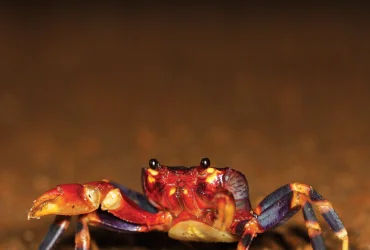 v7i1.160
v7i1.160ISSN: 1800-427X (print)
eISSN: 1800-427X (online)
DOI:10.47605/tapro.v7i1.160
Submitted date: 18 July 2014
Accepted date: 14 October 2014
Published date: 19 January 2015
Pp. 54–55.
Sarus Crane (Grus antigone) egg is hatched by a domestic hen
M. Sandeep, P. Srinivas, B.L Narayana* & D. Adimallaiah
*Corresponding author. E-mail: narayana.laxmi8@gmail.com
Nehru Zoological Park, Hyderabad, Telangana, India, has been involved in captive breeding programmes, including eggs of silver pheasant (Lophura nycthemera), red jungle fowl (Gallus gallus), kalij pheasant (Lophura leucomelanos) and golden pheasant (Chrysolophus pictus) incubated by domestic hen (Gallus gallus domesticus). It proved successful in almost all cases. Here, we attempted to do the same for the sarus crane (Grus antigone), which is listed in Schedule I of the Wildlife (Protection) Act 1972, vulnerable species on IUCN Red List 2012, Appendix II of CITES, and Appendix II of the Convention on Migratory Species. It is the largest bird in India and the tallest flying bird in the world.
Section Editor: Varadharajan Gokula
eISSN: 1800-427X (online)
DOI:10.47605/tapro.v7i1.160
Submitted date: 18 July 2014
Accepted date: 14 October 2014
Published date: 19 January 2015
Pp. 54–55.
Sarus Crane (Grus antigone) egg is hatched by a domestic hen
M. Sandeep, P. Srinivas, B.L Narayana* & D. Adimallaiah
*Corresponding author. E-mail: narayana.laxmi8@gmail.com
Nehru Zoological Park, Hyderabad, Telangana, India, has been involved in captive breeding programmes, including eggs of silver pheasant (Lophura nycthemera), red jungle fowl (Gallus gallus), kalij pheasant (Lophura leucomelanos) and golden pheasant (Chrysolophus pictus) incubated by domestic hen (Gallus gallus domesticus). It proved successful in almost all cases. Here, we attempted to do the same for the sarus crane (Grus antigone), which is listed in Schedule I of the Wildlife (Protection) Act 1972, vulnerable species on IUCN Red List 2012, Appendix II of CITES, and Appendix II of the Convention on Migratory Species. It is the largest bird in India and the tallest flying bird in the world.
Section Editor: Varadharajan Gokula
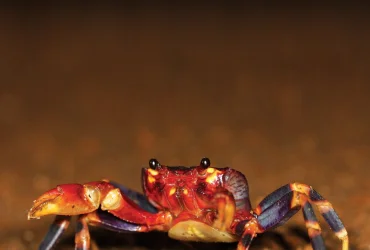 v7i1.159
v7i1.159ISSN: 1800-427X (print)
eISSN: 1800-427X (online)
DOI:10.47605/tapro.v7i1.159
Submitted date: 3 May 2014
Accepted date: 3 December 2014
Published date: 19 January 2015
Pp. 53.
Cannibalism in Ophisops microlepis (Lacertidae) in Rajastan, India
S. Vivek, K. K. Rakesh & K. K Sharma
*Corresponding author. E-mail: sharmakeviv@gmail.com
Ophisops microlepis (Blanford, 1870), the Cutch snake-eyed lacerta, is a common and widely distributed lacertid in the states of Bihar, Gujarat, Madhya Pradesh and Rajasthan of western and central India. It is a fairly large diurnal lacertid having a SVL of 65 mm and a tail length of 145 mm.
Section Editor: John Rudge
eISSN: 1800-427X (online)
DOI:10.47605/tapro.v7i1.159
Submitted date: 3 May 2014
Accepted date: 3 December 2014
Published date: 19 January 2015
Pp. 53.
Cannibalism in Ophisops microlepis (Lacertidae) in Rajastan, India
S. Vivek, K. K. Rakesh & K. K Sharma
*Corresponding author. E-mail: sharmakeviv@gmail.com
Ophisops microlepis (Blanford, 1870), the Cutch snake-eyed lacerta, is a common and widely distributed lacertid in the states of Bihar, Gujarat, Madhya Pradesh and Rajasthan of western and central India. It is a fairly large diurnal lacertid having a SVL of 65 mm and a tail length of 145 mm.
Section Editor: John Rudge
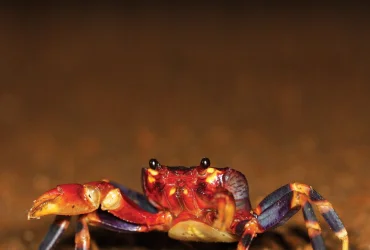 v7i1.158
v7i1.158ISSN: 1800-427X (print)
eISSN: 1800-427X (online)
DOI:10.47605/tapro.v7i1.158
Submitted date: 7 May 2014
Accepted date: 5 January 2015
Published date: 19 January 2015
Pp. 49–52, Pls. 20–21.
Fish die-off in the Attanagalu-Oya River, Sri Lanka: a provisional checklist of icthyofauna
H. Sudasinghe*, P. Suranga & D.M.S.S. Karunarathna
*Corresponding author. E-mail: hsudasinghe@gmail.com
Attanagalu Oya basin is situated between the two major river basins Kelani and Maha Oya in Western province of Sri Lanka and has an extent of 779 km2. It plays a major role in national water supply since it contains four major national water supply and drainage board intakes. This short communication intends to provide a recent report of fish die-off in the Attanagalu Oya and also include provisional checklist of icthyofaunal diversity in the area. The fish faunal data were collected from the catches of fishermen using cast nets, and hooks. In addition, fish in shallow areas were sampled by using small trawl nets and hand nets. Freshwater fish species were identified and classified by using published field guides and recent taxonomic research papers.
Section Editor: S.M. Henkanaththegedara
eISSN: 1800-427X (online)
DOI:10.47605/tapro.v7i1.158
Submitted date: 7 May 2014
Accepted date: 5 January 2015
Published date: 19 January 2015
Pp. 49–52, Pls. 20–21.
Fish die-off in the Attanagalu-Oya River, Sri Lanka: a provisional checklist of icthyofauna
H. Sudasinghe*, P. Suranga & D.M.S.S. Karunarathna
*Corresponding author. E-mail: hsudasinghe@gmail.com
Attanagalu Oya basin is situated between the two major river basins Kelani and Maha Oya in Western province of Sri Lanka and has an extent of 779 km2. It plays a major role in national water supply since it contains four major national water supply and drainage board intakes. This short communication intends to provide a recent report of fish die-off in the Attanagalu Oya and also include provisional checklist of icthyofaunal diversity in the area. The fish faunal data were collected from the catches of fishermen using cast nets, and hooks. In addition, fish in shallow areas were sampled by using small trawl nets and hand nets. Freshwater fish species were identified and classified by using published field guides and recent taxonomic research papers.
Section Editor: S.M. Henkanaththegedara
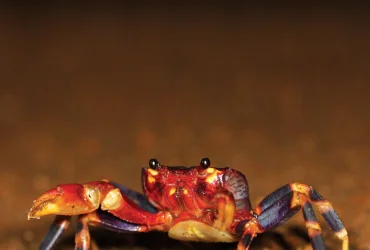 v7i1.157
v7i1.157ISSN: 1800-427X (print)
eISSN: 1800-427X (online)
DOI:10.47605/tapro.v7i1.157
Submitted date: 16 April 2014
Accepted date: 2 January 2015
Published date: 19 January 2015
Pp. 47–48, Pls. 18–19.
Range extension of Pethia nigripinna (Cyprinidae) to Karnataka, India
J.D.M. Knight*, A. Rai, R.K.P. D’souza & B. Vijaykrishnan
*Corresponding author. E-mail: jdmarcusknight@yahoo.co.in
The black-finned barb, Puntius nigripinnis Knight et al., 2012 currently designated to the genus Pethia Pethiyagoda et al., 2012 is a little known barb described from the east flowing Cauvery River basin. The present knowledge on the range of Pethia nigripinna is based only from its original description, as there have been no subsequent records of this species from the Western Ghats. Until now, P. nigripinna is known to occur only in Kalindhi stream, Kabini River in Wayanad, Kerala and Kakkan halla, Moyar River, Tamil Nadu.
Section Editor: S.M. Henkanaththegedara
eISSN: 1800-427X (online)
DOI:10.47605/tapro.v7i1.157
Submitted date: 16 April 2014
Accepted date: 2 January 2015
Published date: 19 January 2015
Pp. 47–48, Pls. 18–19.
Range extension of Pethia nigripinna (Cyprinidae) to Karnataka, India
J.D.M. Knight*, A. Rai, R.K.P. D’souza & B. Vijaykrishnan
*Corresponding author. E-mail: jdmarcusknight@yahoo.co.in
The black-finned barb, Puntius nigripinnis Knight et al., 2012 currently designated to the genus Pethia Pethiyagoda et al., 2012 is a little known barb described from the east flowing Cauvery River basin. The present knowledge on the range of Pethia nigripinna is based only from its original description, as there have been no subsequent records of this species from the Western Ghats. Until now, P. nigripinna is known to occur only in Kalindhi stream, Kabini River in Wayanad, Kerala and Kakkan halla, Moyar River, Tamil Nadu.
Section Editor: S.M. Henkanaththegedara
Hubungi Kami
The ultimate aim of the journal is to provide an effective medium for communication of the latest and best scientific information.
Copyright © 2020 Taprobanica. All Rights Reserved
Jasa Pembuatan Website by IKT




